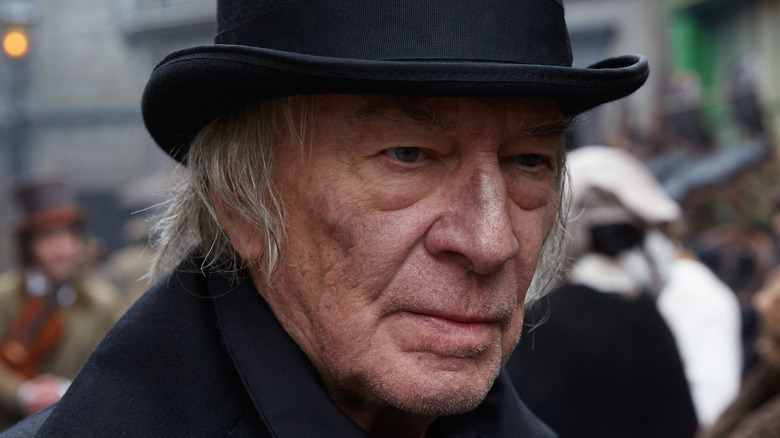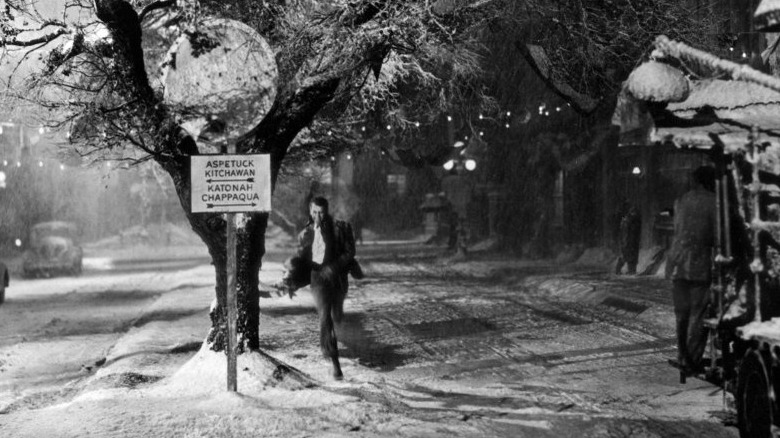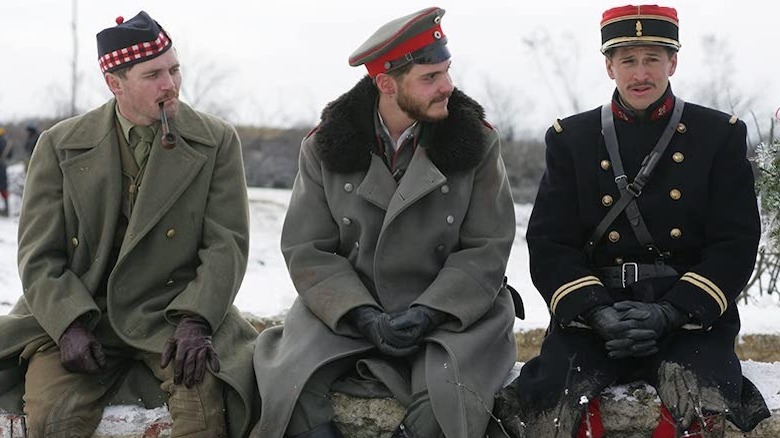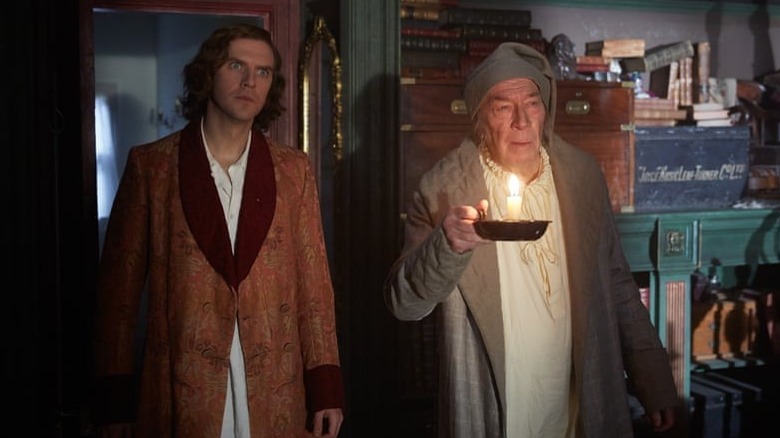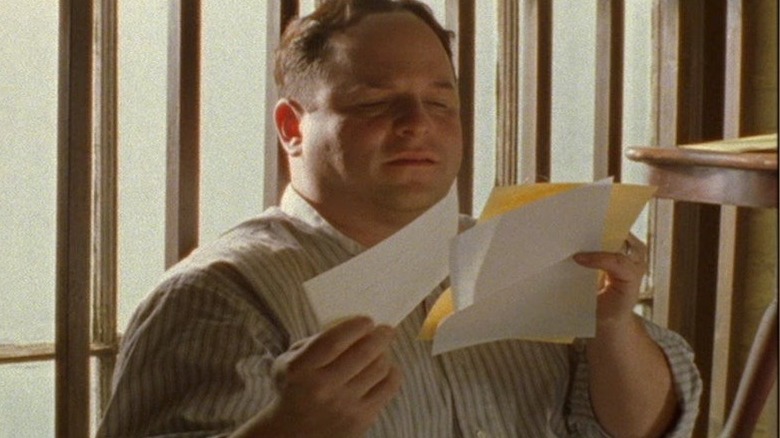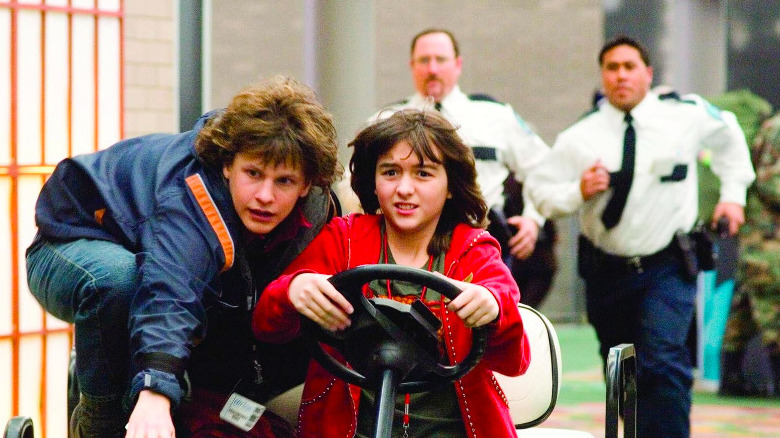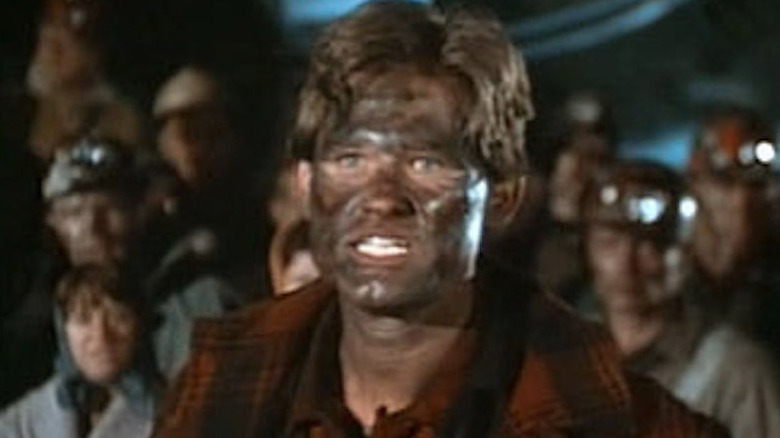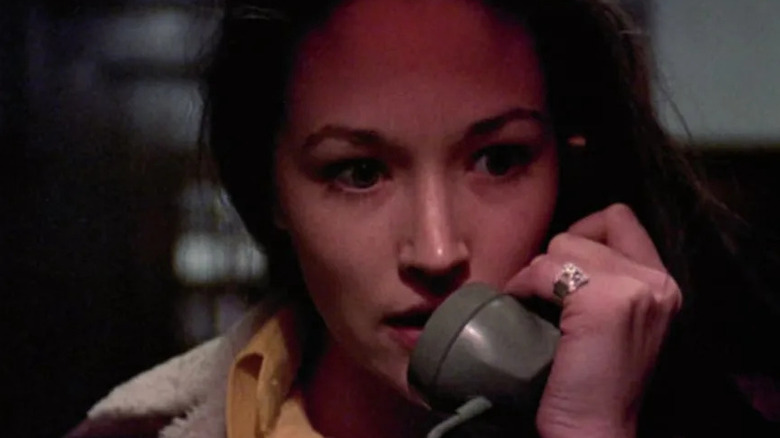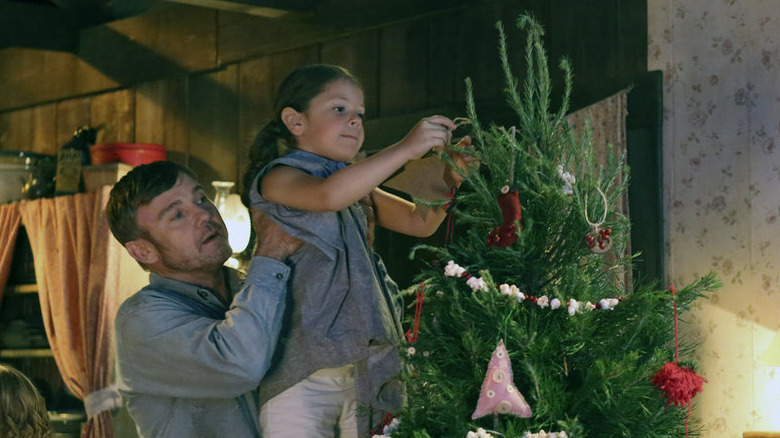12 Christmas Movies That Are Based On A True Story
For the most part, Christmas movies are a lot like the holiday itself: sweet, filled with emotion and good cheer, and often sprinkled with a bit of magic to appeal to the child in every viewer. That's not to say that every Christmas movie is a fantasy, but the ones that seem to endure in our hearts and memories, like "It's a Wonderful Life" or "A Christmas Story," have one foot planted in the everyday world, and the other in a winter wonderland where wishes come true, families reunite, and for just one day, everything feels right.
For filmmakers, the solution to delivering such a mix is simple. They create the story from a patchwork of imagination and happy memories. But there are many Christmas movies that were inspired, either entirely or in part, by real-life scenarios. These include at least one bona fide holiday classic, a few surprises, and a whole lot of Hallmark titles. Following is a spoiler-heavy list of 12 Christmas movies that are based on a true story.
The real Bedford Falls from It's a Wonderful Life
Frank Capra's 1946 fantasy-drama "It's a Wonderful Life" is one of the quintessential holiday movies, thanks in part to annual December airings on television. The film delivers not only a heartwarming and life-affirming message about the value of each person's existence, but also a postcard-perfect snapshot of life in a small American town. For many years, the town of Seneca Falls, New York, has laid claim to the notion that they inspired Capra's vision for the film's idealized setting of Bedford Falls.
According to NPR, the town's historian, Chris Podzuweit, claimed that Capra visited the town in the 1940s and explored its many landmarks, including its main street and bridge, both of which resemble downtown Bedford Falls and the bridge where Jimmy Stewart's George Bailey has his darkest moment. The town has further linked its identity with that of Bedford Falls with an "It's a Wonderful Life" museum and annual festival devoted to the movie.
Some, like historian Jeanine Basinger, who curates the Frank Capra Archives at Wesleyan University, have questioned Seneca Falls' claim. "There is just not evidence to support it, but God bless them," she told the San Diego Union-Tribune. But others, like actress Karolyn Grimes, who played Zuzu Bailey in the film, are wholly on board with the idea. "It's got the canal, it's got the names of streets, it's got the Victorian houses – I mean, it's got it all," she told NPR.
8-Bit Christmas recalled '80s Nintendo mania
The 2021 HBO Max comedy "8-Bit Christmas" is an anarchic but warm-hearted tribute to not only the highs and lows of the holiday season, but also the mania generated by '80s-era toys and games like the Nintendo Entertainment System. The film's writer, Kevin Jakubowski, adapted his own novel of the same name, which took place in his home state of Illinois. In an interview for the "Gamer Looks at 40" podcast, Jakubowksi noted that while some of the scenes were heightened for comic effect, his own childhood experiences also inspired a great deal of the story.
"[The story] came from wanting a Nintendo, and all my friends really wanting it, in '87, '88," he explained. One of the film's most uproarious scenes — in which wealthy kid Chandler Dean grants access to his Nintendo like a king bestowing a knighthood — comes directly from Jakubowski's own memories. "I remember riding bikes to his house and hoping I got there soon enough to be one of the four or five kids his parents would let inside to play it," he shared. Many other aspects of the story, including the dynamic in Winslow Fogler's on-screen family and the town in which it takes place, were also assembled from Jakubowki's childhood. "Everything in the book is heightened and exaggerated ... all of those things are inspired by real life and my childhood," he said.
Joyeux Noel depicted a all-too-brief truce in WWI
The 2005 feature "Joyeux Noel" depicts a remarkable moment in the carnage of World War I: A temporary truce brokered between French, Scottish, and German soldiers, who left their trenches during Christmas and shared songs and gifts. The multinational production, which featured early screen appearances by Daniel Bruhl ("Captain America: Civil War") and Diane Kruger ("The 355") and earned an Oscar nomination for best foreign film, depicts a real-life event that took place on the battle lines in 1914.
Truces between opposing forces were not uncommon during the early days of World War I, but were typically relegated to individual soldiers or smaller units. The informal Christmas truce of 1914 reportedly involved approximately 100,000 troops on the Western Front near Belgium on December 24. German soldiers began singing Christmas carols and invited their British and French counterparts to join them in No Man's Land — the area between the trenches — to celebrate the holiday. The troops exchanged gifts of tobacco and alcohol and even played soccer during the truce, which in some areas reportedly lasted several days. The Christmas Truce of 1914 was reportedly the last such widespread cessation of fighting during World War I; the sheer amount of casualties on both sides made it harder to put aside grievances for a night, even on Christmas.
The Man Who Invented Christmas looks at the life of Charles Dickens
The 2017 Irish-Canadian biopic "The Man Who Invented Christmas" examines the events in the life of author Charles Dickens that reportedly inspired him to write his enduring holiday novella "A Christmas Carol." The film, directed by Bharat Nalluri and starring Dan Stevens as Dickens, takes creative liberties in depicting the inspiration for the story: As NPR reviewer Mark Jenkins noted, Dickens appears surrounded by the characters in his own story like Dorothy in "The Wizard of Oz."
However, "The Man Who Invented Christmas" also accurately depicts many of the biographical details in Dickens' life. His father, played in the film by Sir Jonathan Pryce, did go to debtors' prison when Dickens was 12 years old, and Dickens' career was in a tailspin prior to the publication of "A Christmas Carol." Individuals from Dickens' own life also inspired some of the characters in his works, though the character played by Christopher Plummer is just one of several suggested figures that inspired his creation of Ebenezer Scrooge. And Dickens did self-publish "A Christmas Carol" after falling out with his publishers; it was a costly move that ended up netting him a far smaller share of the profits.
Jason Alexander played The Man Who Saved Christmas
CBS aired the made-for-TV feature "The Man Who Saved Christmas" in 2002, which gave Jason Alexander a rare shot at leading man status as entrepreneur A.C. Gilbert, who created the Erector set (among many other products for kids) in 1913. The film follows Gilbert's efforts to assist the United States during World War I by turning his toy factory into a manufacturing plant, as well as his fight against the government's decision to encourage people to buy war bonds instead of Christmas gifts. Due to his successful lobbying, the press of the day dubbed Gilbert "the man who saved Christmas."
Save for the usual liberties with historical fact (Gilbert's son, who was born after World War I, is seen as a 10-year-old in the film), "The Man Who Saved Christmas" essentially follows Gilbert's campaign to encourage Americans to buy and give gifts during the holidays. Alexander pours on the charm as Gilbert and is very effective in a largely dramatic role (though it's a little difficult to believe that he is an Olympic gold medalist, as Gilbert was in real life). And the film does make note of many of Gilbert's accomplishments outside of toy-making: He was among the first business owners to provide benefits, such as medical insurance and Christmas bonuses, to his employees.
The sad true story behind Unaccompanied Minors
Despite the presence of "Bridesmaids" director Paul Feig behind the camera and a host of comedy pros in supporting roles, the comedy "Unaccompanied Minors" landed with a thud during its brief theatrical run in December 2006. The film follows a gaggle of kids, all designated with the titular label (children on a flight without an legal guardian), who run amuck in a Midwestern airport when their Christmas Eve flights are grounded. However, the closest the script comes to delivering on its premise is a string of underfed sight gags –- something that even grown-up players like Lewis Black, Paget Brewster, Rob Corddry, Mindy Kaling, and Tony Hale couldn't rescue.
"Unaccompanied Minors" was loosely based on writer Susan Burton's "In the Event of an Emergency, Put Your Sister in the Upright Position," a segment from a 2001 episode of the NPR radio series "This American Life." Unlike "Unaccompanied Minors," Burton's piece is serious and frequently melancholy as she recalls a childhood spent on flights, shuttling between divorced parents with her younger sister. One such trip ends abruptly when Chicago's O'Hare airport is snowed in, forcing Burton and other unaccompanied minors into a sort of holding pen until the airlines could contact parents. The story is thoughtful and emotional in a way that the film can't begin to touch.
Christmas Miracle in Caufield U.S.A. is a sanitized take on a tragedy
The "miracle" mentioned the title of the 1977 NBC TV movie "Christmas Miracle in Caufield, U.S.A." refers to the rescue of miners trapped by a cave-in on Christmas Eve in 1951, but that storyline actually comprises only a portion of the film. Small town drama takes up much of the runtime, especially the miserly actions of the mine owner (Don Porter) and his impact on a family that works for him, including patriarch Mitchell Ryan, booksmart son Kurt Russell, and daughter Melissa Sue Gilbert, who also narrates the film. Their scenes are well acted but don't grip the viewer in the same manner as the cave-in.
The accident itself appears to be based on a mine accident that took place in West Frankfort, Illinois on December 21, 1951. An underground explosion of methane gas tore through the Orient #2 mine shortly before it was scheduled to close for the Christmas holiday, killing 119 mineworkers. The disaster – the worst of its kind since 1940 — prompted the intervention of the federal government, which passed the Coal Mine Safety Act in 1952.
The terrifying crime that may have inspired Black Christmas
Though it's been remade twice, the original 1974 version of "Black Christmas" remains not only one of the best holiday-themed horror movies, but a high point in the history of the slasher film. The Canadian production, directed by Bob Clark — who, ironically, would enjoy lasting fame as the director of the beloved "A Christmas Story" — was in part inspired by an enduring urban legend known as "The Babysitter and the Man Upstairs." The grisly story, in which a sitter receives terrifying phone calls asking her to check on the children she's watching, inspired several other horror films (including "When a Stranger Calls") and was itself reportedly based on a real-life unsolved murder case from 1950.
However, the film's gruesome murder spree, carried out by an unseen assailant on the members of a college sorority, may have been influenced by several other real-life crimes. In an interview on the 2008 Blu-ray release of the film (via CBC Arts), screenwriter Roy Moore has alluded to a string of gruesome murders committed in Montreal and Calgary during the late 1960s by serial killer Wayne Clifford Boden as a possible inspiration. However, co-star Nick Mancuso suggested in an interview with Telegraph that the story drew upon a 1943 murder case in Montreal's Westmount neighborhood.
Dolly Parton drew on her family's holidays for Circle of Love
The 2015 NBC TV movie "Dolly Parton's Coat of Many Colors" earned critical praise for its heartfelt narrative, which was drawn from stories about Parton's own childhood. A sequel, "Dolly Parton's Christmas of Many Colors: Circle of Love," followed in 2016 — The film, about her family facing various challenges at the holidays, netted an Emmy Award nomination for outstanding television movie in 2017.
In an interview with The Country Daily, Parton said that "Christmas of Many Colors" was drawn from "other true stories from my life." Its central story — about Parton's father (played by Rick Schroeder) and siblings pooling their meager resources to buy their mother (Jennifer Nettles) a wedding ring — helped to provide the film with its title. "[The ring] represents the circle of love," she explained.
As executive producer of the movie, Parton was on set for much of the production, and found that some scenes drawn from her life were hard to watch. One in particular, which depicted her family facing the possibility of freezing to death after being snowed in, was a particularly emotional experience for her. "When we got to the part when Mama was praying and the tears were frozen on our little faces — when I was watching that, I just couldn't hardly bear it," she said.
Christmas Princess is an uplifting story about family
Not all holiday movies are merry and bright. Case in point: "Christmas Princess," a 2017 production for UP TV, which ventures down a few dark paths in its story of teenager Donaly Marquez (played by Nicole Munoz), who endures both abuse at the hands of her drug-addicted mother and the heartbreak of the foster living system. Thankfully, the film has a silver lining: Donaly achieves her long-standing dream of becoming a princess in Pasadena's famous Tournament of Roses Parade.
The highs and lows of Donaly's story are made even more moving by the fact that they are also true. As a 2015 story in the Los Angeles Times illustrated, she and her siblings were neglected by their birth mother, who eventually surrendered them at a police station. The trio was shuttled through various group homes before being adopted by Sara and Ignacio Marquez (played by Rosa Blasi and Zak Santiago in the film).
With her family situation now stabilized, Donaly launched her campaign for the Tournament's Royal Court. And as the Los Angeles Times article noted, Donaly also took her story to Los Angeles group homes to show other young people that they could escape the cycle of neglect. "It doesn't matter where you come from, you can do anything as long as you set your mind to it," she said.
Operation Christmas Drop highlights real heroes along with holiday romance
What happens when an ambitious congressional assistant (Kat Graham) tasked with closing a US Air Force base in Guam meets the handsome nice-guy captain (Alexander Ludwig) in charge? Sparks fly, of course, as the 2020 Netflix romcom "Operation Christmas Drop" details, but viewers also get a bit of history in addition to the heart-melting moments. The humanitarian missions carried out by Ludwig and his crew, which involve airlifting much-needed goods to island residents, are not only real, but a long-standing holiday tradition in the Pacific region.
Since 1952, Air Force crews stationed on Guam have been airdropping food and other supplies to some of the 2,000 islands that make up the tiny Pacific Ocean region of Micronesia. The 400-pound boxes of essential items, which are donated by businesses and individuals on Guam, are dropped via parachute from Air Force cargo plants to the islands' inhabitants, who often depend on the Christmas Drop donations for food, medicine, and other necessities. And while "Operation Christmas Drop" depicts a scenario in which the government plans to cancel the supply deliveries, the real Christmas drop remains active today, and is the longest-running humanitarian airlift in the world.
A stranger's kindness led to love in Once Upon a Christmas Miracle
An extraordinary gift brings not only new life but also a chance at new love in the 2018 Hallmark Movies & Mysteries feature "Once Upon a Christmas Miracle." Aimee Teagarden stars as a young woman whose desperate need for a liver transplant is answered by a complete stranger (Brett Dalton). His selfless act leads to a tentative connection that eventually blossoms into romance and marriage.
Though the plot of "Christmas Miracle" sounds like the stuff of Hollywood romcom fantasies, it's actually based on a real-life couple, Heather Krueger and Chris Dempsey (via Chicago Tribune). Krueger had autoimmune hepatitis, which by 2015 had so compromised her health that doctors advised her to seek out a liver donor. By chance, Dempsey overheard Krueger's cousin talking about her condition and decided to become her donor. The operation was a success, but even more remarkable was the bond that grew between the couple: They became engaged within months, and eventually married. In addition to lending their real-life fairy tale to the Hallmark production, Krueger and Dempsey also appear briefly in the film as a couple dancing at a fundraising event to pay for medical expenses.
